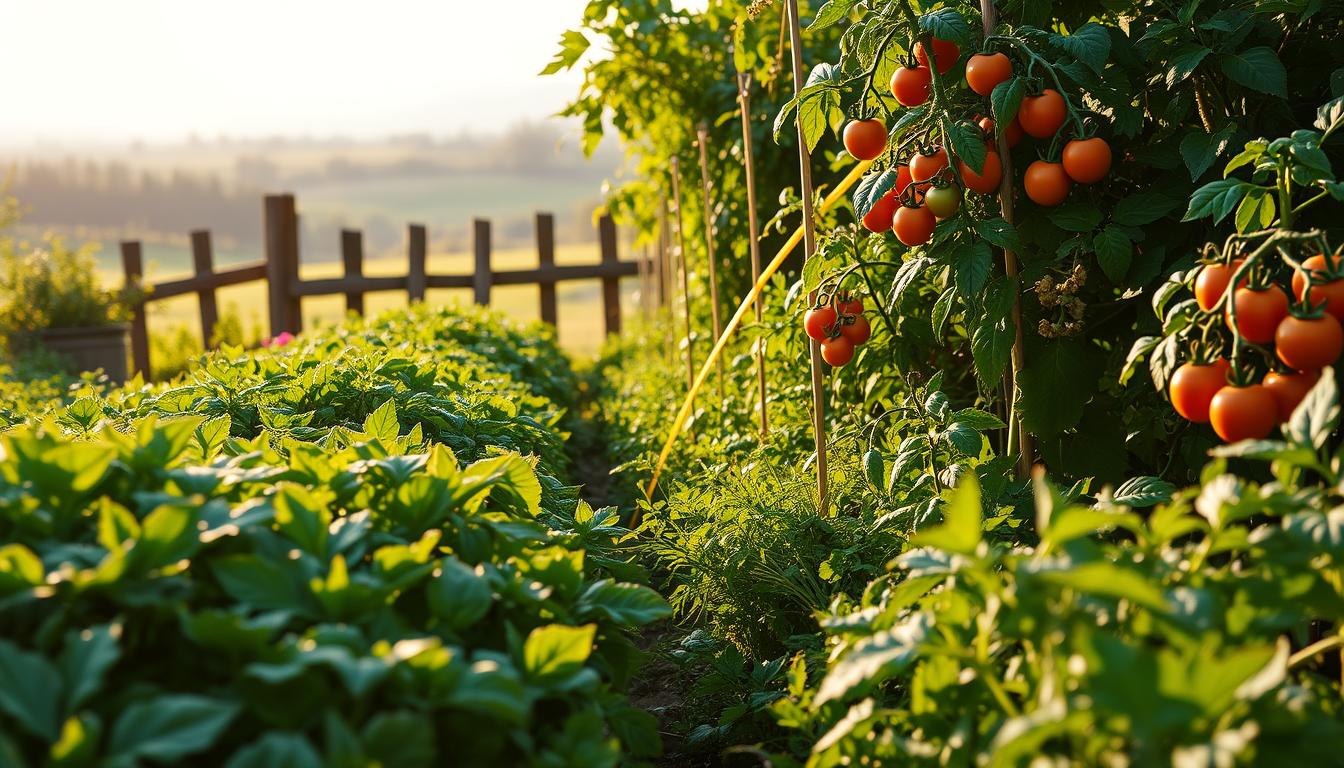Growing your own vegetables at home is a rewarding experience. Imagine plucking fresh tomatoes or zucchini right from your backyard. The taste is unmatched, and the process connects you with nature in a meaningful way.
Starting a garden doesn’t have to be complicated. With the right guidance, you can enjoy fresh, flavorful food while saving money. This guide will walk you through essential steps like choosing the perfect spot, preparing the soil, and selecting the best plants for your space.
We’ll also explore companion planting and starter plans to make your journey easier. Whether you’re in USDA Zone 5 or 9, the Old Farmer’s Almanac Garden Planner can help. Let’s dig in and discover the joy of harvesting your own veggies!
Key Takeaways
- Fresh, homegrown vegetables taste better and save money.
- Choose the right location and prepare the soil for success.
- Companion planting can boost your garden’s health.
- Use tools like the Old Farmer’s Almanac Garden Planner.
- Harvesting your own produce is deeply satisfying.
Why Start a Vegetable Garden?
There’s nothing quite like biting into a tomato still warm from the sun. Homegrown vegetables offer a flavor that store-bought produce simply can’t match. The freshness and quality of your food are unmatched when you grow it yourself.
Health benefits are another major reason to start a garden. You control what goes into your plants, ensuring no harmful pesticides. This means maximum nutrients and better-tasting veggies for your meals.
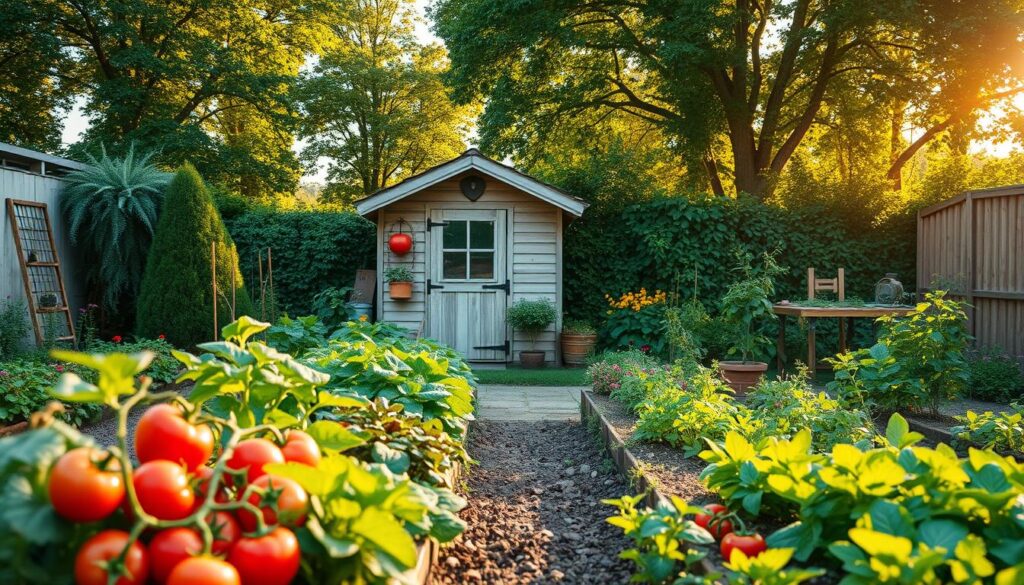
Gardening also provides mental and physical benefits. Spending time outdoors reduces stress and encourages physical activity. According to USDA data, more Americans are turning to home gardening for these reasons.
Cost savings are another perk. For example, a $5 herb plant can yield far more than $3 grocery packets. Plus, it’s a fun and educational activity for kids, teaching them where their food comes from.
Environmental benefits are significant too. Growing your own vegetables reduces food miles, cutting down on transportation emissions. As one gardener put it,
“There’s absolutely nothing quite like fresh veggies.”
First-time gardeners often share inspiring success stories. From small patio plants to full backyard gardens, the joy of harvesting your own food is deeply rewarding. Whether it’s a single season or a year-round hobby, the benefits are endless.
How to Choose the Perfect Spot for Your Garden
Finding the ideal location for your garden is the first step to success. The right site ensures your plants get the sunlight, water, and protection they need to thrive. Let’s explore the key factors to consider when selecting the perfect spot.
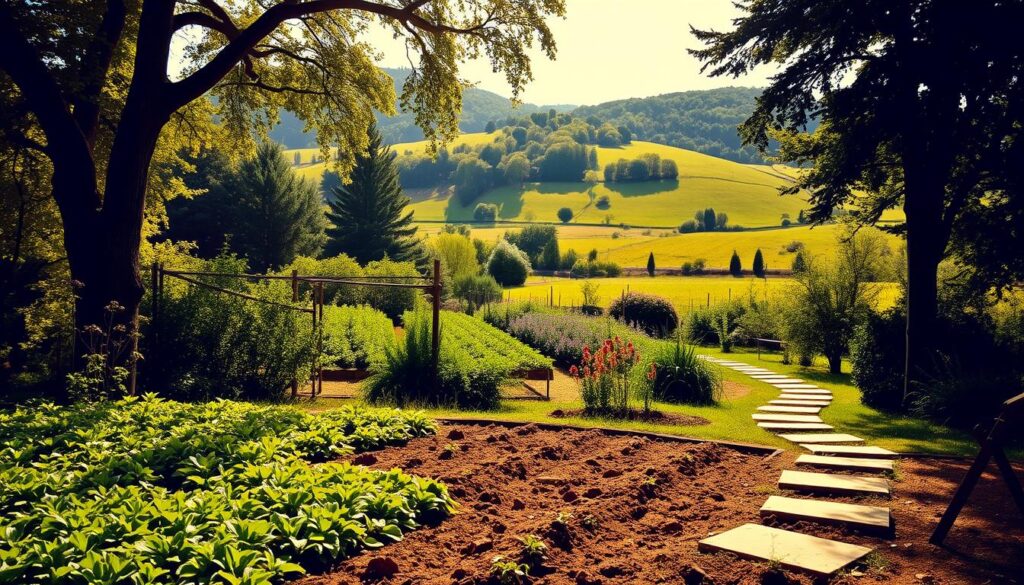
Sunlight and Drainage
Most plants require 6-8 hours of direct sunlight daily. Use free apps or simple observation to track how sunlight moves across your space. Morning sun is gentler, while afternoon sun can be intense, especially in hot climates.
Drainage is equally important. Test your soil’s drainage with a percolation test. If water pools, consider raised beds to improve water flow. The ideal soil pH for most plants is between 6.0 and 7.0, which you can check with a soil thermometer.
Protection from Wind and Foot Traffic
Strong winds can damage plants and dry out soil. Build windbreaks using burlap, shrubs, or fences to shield your garden. Avoid areas with heavy foot traffic to prevent soil compaction and root damage.
Microclimates near walls or fences can also affect your garden. These areas may stay warmer in cooler weather, extending your growing season. However, be cautious of tree roots that can compete for water and nutrients.
“The Goldilocks principle applies to gardening—not too much, not too little, but just right.”
By considering sunlight, drainage, and protection, you’ll create a space where your plants can flourish. For more tips on getting started, check out this beginner’s guide to gardening.
Preparing Your Soil for Planting
Healthy soil is the foundation of a thriving garden. Without proper preparation, even the best plants may struggle to grow. Start by testing your soil to understand its composition and pH levels. Local extension services often offer affordable testing kits that provide detailed insights.
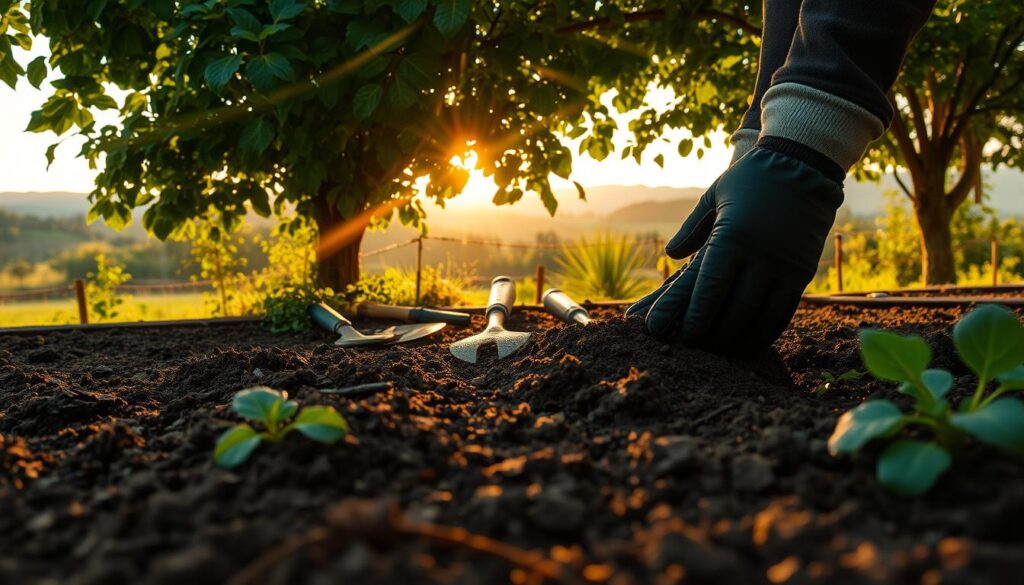
Once you know your soil’s needs, it’s time to amend it. Adding 2-3 inches of organic matter, like compost, can improve clay soils. For container gardening, mix one part sand, one part organic matter, and two parts loam. The ideal soil should crumble when squeezed, indicating good structure and drainage.
Soil Testing and Amendments
Testing your soil is a simple yet crucial step. Most plants thrive in soil with a pH between 6.0 and 7.0. If your soil is too acidic, add lime. For alkaline soils, sulfur can help balance the pH. Worm castings are another excellent amendment, enriching the soil with nutrients and improving its texture.
Consider cover cropping during the off-season. Plants like clover or rye add organic matter and prevent erosion. They also suppress weeds, making your garden easier to manage when planting season arrives.
Raised Beds vs. In-Ground Planting
Choosing between raised beds and in-ground planting depends on your space and needs. Raised beds offer better drainage and are ideal for areas with poor soil. They also reduce strain on your back, making gardening more comfortable. Building a 4×4 raised bed is a straightforward project that can yield impressive results.
In-ground planting is cost-effective and works well if your soil is already healthy. However, avoid over-compaction by tilling to a depth of 6-8 inches. Lasagna gardening is a no-till option that layers organic materials directly on the ground, creating rich soil over time.
“Investing in your soil is investing in your garden’s future.”
Whether you choose bagged or bulk soil, ensure it’s high quality. For more tips on soil preparation, check out this beginner’s guide to gardening. With the right foundation, your garden will flourish, providing fresh produce for years to come.
Choosing the Right Vegetables for Your Garden
Selecting the right crops can make your gardening journey smoother and more enjoyable. The key is to pick plants that match your skill level, space, and climate. Whether you’re a beginner or an experienced gardener, the right choices ensure a bountiful harvest.
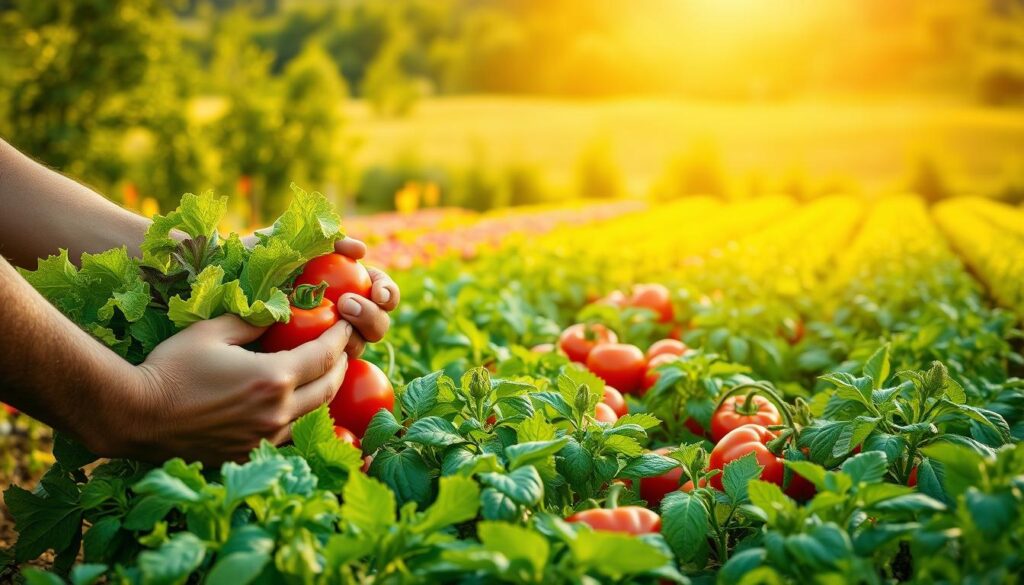
Easy-to-Grow Vegetables for Beginners
Starting with simple vegetables can boost your confidence. Lettuce, beans, and radishes are excellent options for beginners. These crops grow quickly and require minimal care. Tomatoes and zucchini are also popular choices, offering high yields with moderate effort.
For impatient gardeners, quick-growing veggies like lettuce and radishes are ideal. They can be harvested in as little as 30 days. Consider succession planting to extend your harvest. Stagger plantings every two weeks for a continuous supply of fresh produce.
Considering Your Climate and Season
Your local climate plays a crucial role in plant selection. Use the USDA Plant Hardiness Zone Map to identify your zone. This helps you choose plants that thrive in your area. For example, tomatoes and squash prefer warm weather, while lettuce and radishes grow well in cooler temperatures.
Extreme weather can be managed with tools like shade cloth or row covers. These protect your garden from frost or intense heat. Companion planting is another smart strategy. For instance, marigolds deter pests when planted near tomatoes.
“The right plant in the right place makes all the difference.”
| Type | Determinate Tomatoes | Indeterminate Tomatoes |
|---|---|---|
| Growth Habit | Bushy, stops growing after fruiting | Vining, continues growing all season |
| Harvest | All at once | Continuous |
| Space Needed | Compact, ideal for containers | Requires trellis or support |
Hybrid and heirloom varieties offer different benefits. Hybrids are often more disease-resistant, while heirlooms provide unique flavors. Edible flowers like nasturtiums add beauty and flavor to your garden. Always check seed packet terminology to understand planting depth, spacing, and days to maturity.
Planting Your Vegetable Garden
The joy of watching seeds sprout into healthy plants is unmatched. Whether you’re starting from seeds or using seedlings, proper planting techniques ensure a thriving garden. Let’s explore the best practices to get your crops off to a strong start.
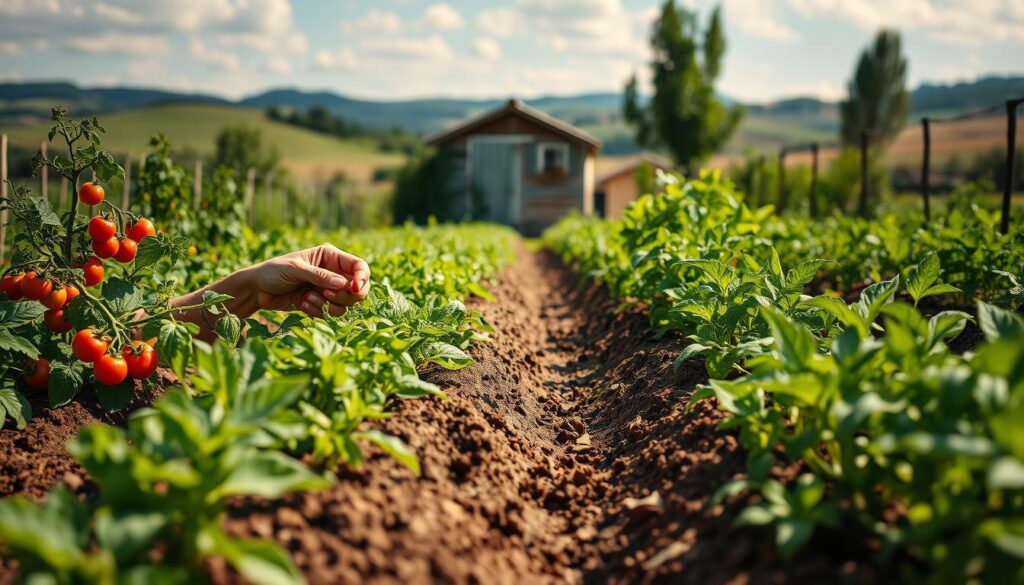
Starting from Seeds vs. Transplants
Starting from seeds gives you full control over the growing process. Sow them 1/4 to 1/2 inch deep, depending on the type. Use a 5-10-5 fertilizer starter solution to boost early growth. For faster results, seedlings are a great option. Transplant them in the late afternoon to reduce stress.
Heat mats can speed up germination, especially for warm-season plants like tomatoes and cucumbers. DIY cloches made from milk jugs protect young plants from frost. Remember, seeds have viability timelines, so check the packet for freshness.
Spacing and Companion Planting
Proper space ensures healthy growth. Use household items like coins to measure seed spacing. Square foot gardening maximizes space by dividing the area into grids. For example, plant one tomato per square foot and four beans in another.
Companion planting boosts your garden’s health. Pair beans with corn or tomatoes with basil. Trellising beans saves space and improves air circulation. Moon phase planting, though folklore, is a fun tradition some gardeners swear by.
“The right spacing and companions make all the difference in a thriving garden.”
By following these tips, you’ll set your garden up for success. Whether you’re a beginner or a seasoned gardener, the process of planting is both rewarding and educational.
Maintaining Your Vegetable Garden
Keeping your garden healthy requires consistent care and attention. Proper watering, fertilizing, and pest control are essential for thriving plants. With a little effort, you can ensure your vegetables grow strong and productive.
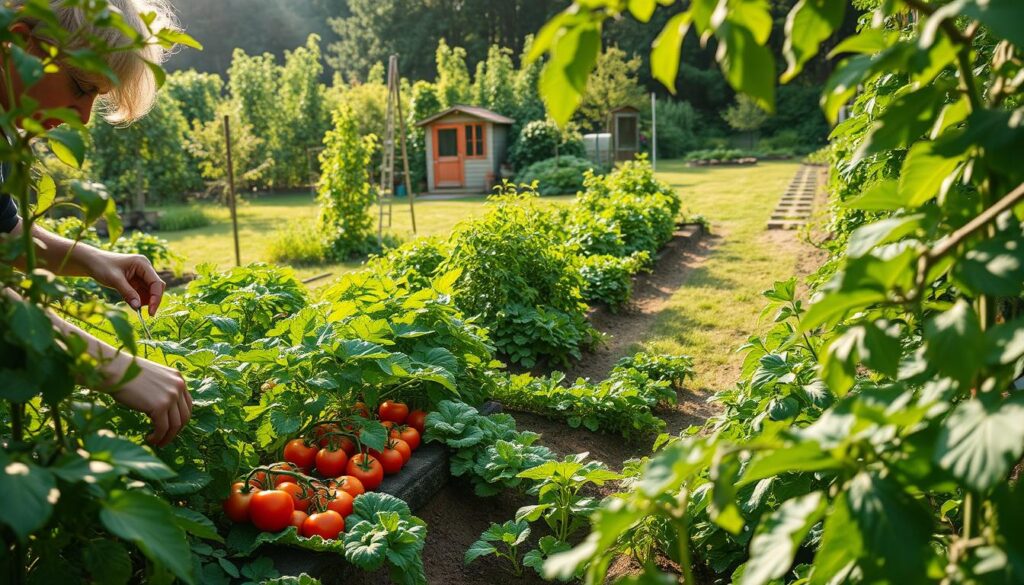
Watering and Fertilizing Tips
Water is vital for your garden. Check the soil moisture by inserting your finger about 1/2 inch deep. If it feels dry, it’s time to water. Use a drip irrigation system with smart timers for efficiency. This method delivers water directly to the roots, reducing waste.
Fertilizing keeps your plants nourished. Apply 1½ tablespoons of 5-10-5 fertilizer per gallon of water. This balanced mix provides essential nutrients. For containers, ensure proper drainage to avoid overwatering.
“A well-watered and fertilized garden is a happy garden.”
Dealing with Pests and Weeds
Pests and weeds can harm your garden. Use DIY sprays like neem oil to deter insects. Beneficial bugs like ladybugs and lacewings also help control pests naturally. Crop rotation prevents soil depletion and reduces pest buildup over time.
Mulching is another effective strategy. It suppresses weeds and retains soil moisture. For persistent weeds, consider solarization. This method uses sunlight to kill weed seeds and pathogens.
| Nutrient | Role | Source |
|---|---|---|
| Nitrogen (N) | Promotes leaf growth | Compost, manure |
| Phosphorus (P) | Supports root development | Bone meal, rock phosphate |
| Potassium (K) | Enhances overall health | Wood ash, kelp meal |
By following these tips, you’ll keep your garden thriving all season long. Healthy plants mean a bountiful harvest of fresh veggies for your table.
Conclusion
Your journey to fresh, homegrown produce is just beginning. With the right steps, your garden can flourish, providing delicious vegetables for your table. Keep a journal to track progress and plan for a fall vegetable garden to extend your harvest.
Don’t hesitate to troubleshoot issues. Resources like local gardening clubs or online forums can help. Share your bounty with neighbors or community groups—it’s a great way to connect and inspire others.
Even a small garden is something to be proud of. Consider adding fruit trees or herbs to expand your homegrown food options. As the season ends, care for your soil by adding compost or cover crops.
Your salad bowl awaits! Start planning your next steps today and enjoy the rewards of gardening.

